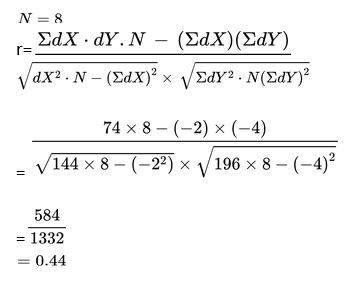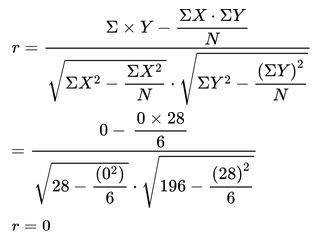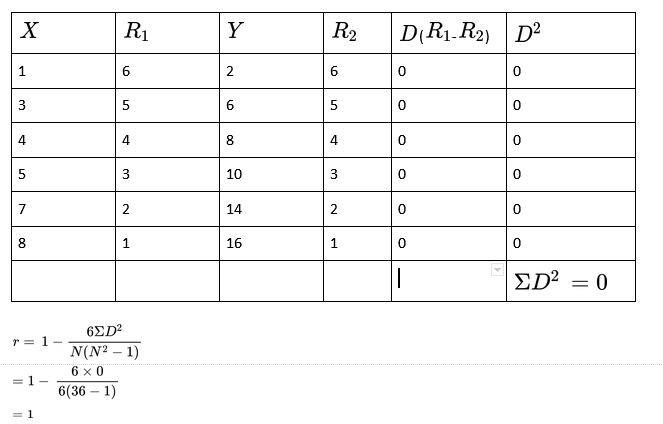
- What is Correlation?
- Weightage of Correlation and Regression
- Illustrative examples on Correlation and Regression
- FAQs on Correlation and Regression
What is Correlation?
Correlation, a statistical concept, is used to calculate the value of the relationship between variables. A real-life example of what this technique calculates is the relationship between price and demand.
Types of Correlation
Correlation can be classified into the following categories.
- Positive and Negative Correlation
- Linear and Non-Linear Correlation
- Simple, Multiple and Partial Correlation
Techniques for measuring correlation
The various techniques used to measure correlation are :
- Scatter diagram
- Karl Pearson’s Coefficient of Correlation represented by the formula
Regression
Linear regression is a statistical tool used to represent a relationship between a dependent variable (usually defined by Y) and a set of other variables (independent variables). It holds immense value in the real world by aiding financial managers to make various investment decisions concerning aspects such as stocks, commodity prices, etc.
Weightage of Correlation and Regression
The concept of correlation and regression is introduced to the students of grade 11 as a part of statistics. The following concept generates high amounts of knowledge, especially in the field of data science. Regression is not evaluated while correlation is tested for 4-8 marks.
Illustrative examples on Correlation and Regression
1. Calculate the correlation coefficient between the heights of fathers in inches (X) and their sons (Y)
| X |
65 |
66 |
57 |
67 |
68 |
69 |
70 |
72 |
| Y |
67 |
56 |
65 |
68 |
72 |
72 |
69 |
71 |
Solution.
| X |
dx(d from AM=67) |
dX² |
Y |
dY(d from AM=68) |
dY² |
dXdY |
| 65 |
-2 |
4 |
67 |
-1 |
1 |
2 |
| 66 |
-1 |
1 |
56 |
-12 |
144 |
12 |
| 57 |
-10 |
100 |
65 |
-3 |
9 |
30 |
| 67 |
0 |
0 |
68 |
0 |
0 |
0 |
| 68 |
+1 |
1 |
72 |
4 |
16 |
4 |
| 69 |
+2 |
4 |
72 |
4 |
16 |
8 |
| 70 |
+3 |
9 |
69 |
1 |
1 |
3 |
| 72 |
5 |
25 |
71 |
3 |
9 |
15 |
| ΣX = 534 |
ΣdX = -2 |
ΣdX² = 144 |
ΣY = 540 |
ΣdY = -4 |
ΣrdY² = 196 |
ΣdXdY=74 |
2. Calculate the correlation coefficient between X and Y and comment on their relationship.
| X |
-3 |
-2 |
-1 |
1 |
2 |
3 |
| Y |
9 |
4 |
1 |
1 |
4 |
9 |
Solution.
| X |
Y |
X² |
Y² |
XY |
| -3 |
9 |
9 |
81 |
-27 |
| -2 |
4 |
4 |
16 |
-8 |
| -1 |
1 |
1 |
1 |
-1 |
| 1 |
1 |
1 |
1 |
1 |
| 2 |
4 |
4 |
16 |
8 |
| 3 |
9 |
9 |
81 |
27 |
There is no linear correlation between the two variables, as X and Y are uncorrected.
3. Calculate the correlation coefficient between X and Y and comment on their relationship
| X |
1 |
3 |
4 |
5 |
7 |
8 |
| Y |
2 |
6 |
8 |
10 |
14 |
16 |
Solution.
∴The two variables are perfectly positive correlated.
FAQs on Correlation and Regression
Q: When two variables move in the same direction, what is the nature of the correlation of two variables?
Q: What is the arithmetical representation of the Coefficient of correlation existing between -1 and +1?
Q: When is the method of rank correlation used for calculation?
Q: Define Regression
Q: Define the line of best fit.
Maths Statistics Exam
Student Forum
Popular Courses After 12th
Exams accepted
CA FoundationExams accepted
ICSI ExamExams accepted
BHU UET | GLAET | GD Goenka TestBachelor of Business Administration & Bachelor of Law
Exams accepted
CLAT | LSAT India | AIBEExams accepted
IPMAT | NMIMS - NPAT | SET
Exams accepted
BHU UET | KUK Entrance Exam | JMI Entrance ExamBachelor of Design in Animation (BDes)
Exams accepted
UCEED | NIFT Entrance Exam | NID Entrance ExamBA LLB (Bachelor of Arts + Bachelor of Laws)
Exams accepted
CLAT | AILET | LSAT IndiaBachelor of Journalism & Mass Communication (BJMC)
Exams accepted
LUACMAT | SRMHCAT | GD Goenka Test




